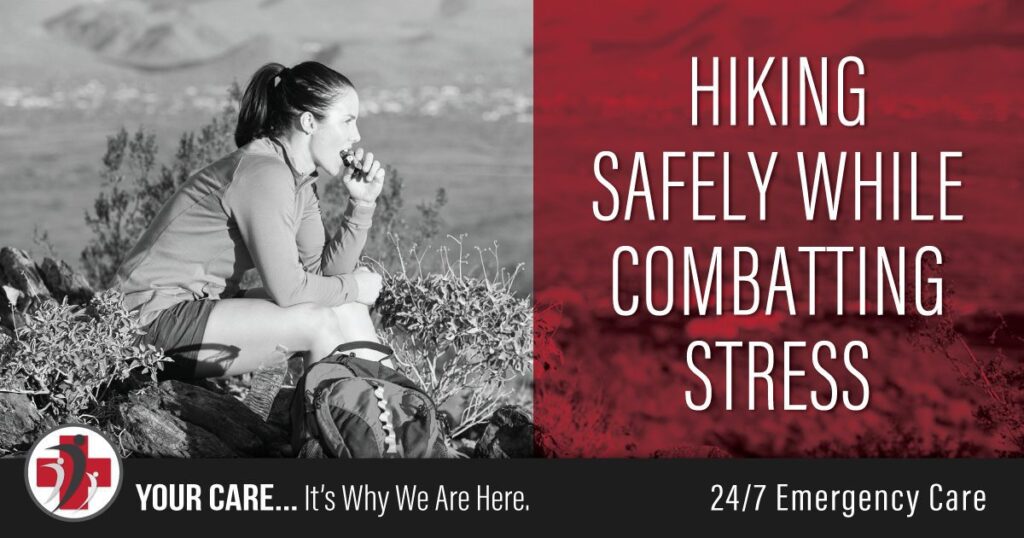STRESS . . . just reading the word can increase those anxious feelings. April is Stress Awareness Month, and we’re keenly aware of how serious the stress pandemic is. The American Institute of Stress reports that 73 percent of people experience stress that impacts their mental health, 77 percent of people report having stress that impacts their physical health, and 48 percent of people report having trouble sleeping because of stress. And what you might believe to be simply a headache, a hot flash, fatigue, body pain, or irritability might actually be Sneaky Stress under cover.
One of our favorite ways to combat feelings of stress is to escape the office grind or house chores for some trail hiking. This coping tactic does more than give you a breath of fresh air. Exercise like hiking can increase endorphins, improve your mood, and help you put your stress into perspective. And here in Arizona, we’re blessed with beautiful spring months, perfect for hiking our endless gorgeous trails. As you prepare to manage your own stress by hitting the trails, the medical staff at Fountain Hills Medical Center want you to keep some important hiking safety tips in mind:
Fuel up: not only is it advisable to eat a breakfast that’s high in carbohydrates and protein before you set out, but you should plan on refueling with 120 to 240 calories of carbohydrates each hour of moderate to fast-paced hiking. Skimp on the carbs and your body will start to burn muscle protein.
Hydrate, hydrate, hydrate: a good rule of thumb is to consume about 2 cups of water per hour in moderate heat, at a moderate pace. If the hike intensity or the temperature rise, then you’ll need more water. Dehydration is a serious risk while hiking in Arizona, and we’ll talk more about the signs, dangers, and treatment of dehydration in our post next month.
Stay on the trail: as tempting as it might be to venture off the path to scale a boulder or capture a sunset picture, going rogue can be dangerous for you and for the surrounding nature. Tromping off the designated trail adds to the erosion of rocks and soil, and can damage delicate foliage.
And not to mention that as you hike off-path you could run into any of Arizona’s 13 species of rattlesnakes and catch them by surprise. Arizona Snake Fence estimates that there are 250-350 rattlesnake bites that occur each year. These critters are not out to hurt you, but they are easily startled and will attack as a defense. They don’t always rattle before they strike, and even dead rattlesnakes can bite.
And what if you do get bit?
For one, forget the old-school tough-guy act of trying to suck out the poison – it’s simply ineffective and dangerous. Medical care is the only way to successfully treat a venomous snake bite. Going to a medical clinic for snake bite care in Arizona, such as Fountain Hills Medical Center, is where you can receive antivenin to counteract the venom.
In the time before you arrive at a medical center, we encourage you to:
- wash the bite with soap and water if possible
- make a note of what the snake looks like
- draw a circle around the bite site
- note the time of the bite to report to medical personnel
- remove watch, rings, or bracelets in vicinity of bitten area
- keep the bitten area still and lower than the heart
- don’t apply a tourniquet, but do gently cover the area with a moist, cool compress
Hiking in Arizona is a great way to keep physically healthy and combat stress. And being mindful of your surroundings to avoid a potential snake bite disaster will allow you an even greater peace of mind. If you have questions about how you can stay safe while hiking in the Phoenix area, or ways we can help treat your stress or anxiety, contact the Fountain Hills Medical Center.
Your Care… It’s why we are here.
Sources not mentioned in post:
Mayo Clinic, Backpacker.com, Azcentral.com, Hopkinsmedicine.org

